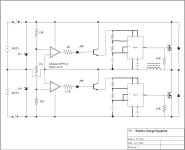I decided to start a new thread since the original thread was getting pretty long.
Here's a schematic I drew up about a year ago for a battery equalizer. This one is designed for a pair of 12v lead batteries. For higher voltages, you gang them like a PowerCheq. The same basic design could be adapted for equalizing Lithum batteries.
This design is theoretical and has not been built or tested. It might not work at all or need some tweaking.
The circulating diodes across the FETs are unnecessary if your FETs have the diodes built in.
This was intended to be sort of a minimum cost circuit, with minimum parts. More features could be added with more complexity. A PIC microprocessor could replace part of the circuit.
An ideal battery equalizer should have the following properties:
-Maintain equal voltage on the cells within a specified tolerance (.05v?)
-Be able to shuttle large currents to maintain equality. At least 2A.
-Operate over a wide voltage range or have a selectable voltage.
-Draw practically zero current when the cells are equal.
-Have some visual indicator of when it is working (or not working).
-Have some indicator of when a cell is weak that points to the weak cell.
-Be fault tolerant and protected against misconnection.
-Contain a minimum of parts or use the cheapest set of parts that would work.
-Compact size
-Minimal heat dissipation
-water resistant
-Dream on...
Here's a schematic I drew up about a year ago for a battery equalizer. This one is designed for a pair of 12v lead batteries. For higher voltages, you gang them like a PowerCheq. The same basic design could be adapted for equalizing Lithum batteries.
This design is theoretical and has not been built or tested. It might not work at all or need some tweaking.
The circulating diodes across the FETs are unnecessary if your FETs have the diodes built in.
This was intended to be sort of a minimum cost circuit, with minimum parts. More features could be added with more complexity. A PIC microprocessor could replace part of the circuit.
An ideal battery equalizer should have the following properties:
-Maintain equal voltage on the cells within a specified tolerance (.05v?)
-Be able to shuttle large currents to maintain equality. At least 2A.
-Operate over a wide voltage range or have a selectable voltage.
-Draw practically zero current when the cells are equal.
-Have some visual indicator of when it is working (or not working).
-Have some indicator of when a cell is weak that points to the weak cell.
-Be fault tolerant and protected against misconnection.
-Contain a minimum of parts or use the cheapest set of parts that would work.
-Compact size
-Minimal heat dissipation
-water resistant
-Dream on...


